

The Elegance of Spring Trilliums Story and photos by Craig Stihler Trilliums, like many wild flowers that grow in deciduous forests, are adapted to take advantage of sunlight reaching the forest floor in the spring before trees leaf-out. The plants must emerge from their winter rest, grow, flower, set seed and store energy reserves for the following year within a short span of time. In spring, the woods are filled with flowering plants racing to complete their activities before they are shaded by trees. Of all the eastern spring wildflowers, trilliums are some of the best known and most beloved. Trilliums, found in eastern and western North America and in Asia , are most diverse in the southeastern United States where nearly 50 species have been described. All trilliums share a simple basic form that is reflected in the “tri” portion of “trillium.” The flowers have three petals, usually white, red, or pink, and three sepals which are usually green to brown in color. The ovary sits in the center of the flower and may be white or colored (color of the ovary is useful in determining species). Six pollen-bearing stamens surround the ovary. The single flower arises from the center of a whorl of three “leaves” that can be solid green or mottled. To some botanists, however, these are not considered true leaves, but leaf-like bracts; the true leaves being reduced to scale-like structures on the underground stem, the rhizome. In one group, the sessile trilliums, the flower does not have a stalk, but sits upon the base of the leaves. A trillium plant begins its life as a seed formed in a fleshy fruit. When ripe, the entire fruit falls from the plant. The seeds have a specialized appendage that is rich in oils and attracts ants. The ants carry the seeds away, eat the fleshy appendages, and leave the seeds to germinate. The seeds do not germinate immediately, but must undergo periods of cooling and warming. Most seeds will not germinate until after their second winter in the ground. Under ideal conditions, the plants will bloom in four or five years and live for decades. Many of us have heard that if you pick a trillium, the plant will die. While this is not true, it is not a good idea to pick trilliums. If the stem with the “leaves” is removed, the plant will not send up a new shoot until the following spring, and must depend on food stores in the underground portions of the plant to survive and sprout the following year. Unless the plant is stressed, it can survive an occasional picking. However, in areas were the new shoots are repeatedly eaten by animals, trilliums may eventually die out. Trilliums are simple and elegant plants. It is no wonder gardeners enjoy growing these plants in their back yards. Several species do make wonderful specimens for woodland gardens and will multiply over the years. If you purchase trillium plants for your garden, buy plants that are commercially propagated and not dug up from the wild. Plants labeled as “nursery stock” may be wild plants that have been grown in a nursery for a short time before being marketed. Trillium plants grow slowly. A commercially raised blooming-size plant will not be cheap, but they will provide years of blooms in your garden. West Virginia's Trilliums Most people in the Mountain State are familiar with the large-flowered white trillium or the red trillium so common across the state, but there are actually 10 different trillium species that have been found in West Virginia. Some of these are quite rare, at least in this state. Trillium catesbaei Common names: Catesby's trillium, rosy wake-robin
Description: Plant may grow to 12 inches. Flowers white to dark rose. Ovary white. Flowers are usually held below the level of the leaves. Anthers are bright yellow. Comments: This plant grows in acid soils, often with mountain laurel and rhododendrons. Trillium cernuum Common name: Nodding trillium
Description: Plant grows to 18 inches. Flowers, with petals up to an inch long, are usually white. Ovary is white or pinkish. Flower stem is short and flower is usually hidden under the leaves. Comments: Prefers cool moist woods. When the site in Jefferson County was last visited, only a few plants remained, and none were in bloom. Trillium erectum Common names: Red trillium, ill-scented trillium, stinking Benjamin, wake-robin.
Description: Plant can grow to be 20 inches tall. Petals usually red, but can be white or pale yellow (as pictured below). Ovary maroon. The flower stem may be bent, but the flowers are usually displayed above the leaves. Comments: This is one of the most common trilliums in the East. The flowers are said to smell like a wet dog. This trillium prefers cool, moderately acidic soils and is often found with mountain laurel and rhododendron. Trillium flexipes Common name: Bent trillium.
Description: Plant is robust, growing to 20 inches. Flowers usually white, but may be reddish brown (pictured) to copper-colored. Ovary white. The flower stem may be erect or angled so that the flower is at or below the leaves. Anthers creamy white. Comments: This is the common white trillium west of the Appalachian Mountains . The flowers are smaller than the large-flowered white trillium and of a heavier texture. Flowers do not turn pink as they age. This trillium is usually found on limestone soils. Trillium grandiflorum Common names: Large-flowered white trillium, white trillium, great white trillium, white wake robin.
Description: Grows to 20 inches. Flowers large. Petals can reach three inches in length (usually less) and half as wide as they are long. Flowers typically white, turning pink as they age. Pink forms are known. Ovary is pale green. Comments: This is the provincial flower of Ontario and the state wildflower of Ohio . Roots were used by native Americans to reduce swelling of the eye and for cramps. This species prefers slightly acid to neutral soils. This may be the easiest trillium to cultivate. Trillium nivale Common names: Snow trillium, snowy trillium, dwarf white trillium
Description: This is our smallest and earliest blooming trillium. Plants are usually less than six inches tall. Flowers white; ovaries white. Leaves have a blue-green coloration. Comments: This uncommon trillium is almost always associated with limestone in areas where leaf litter does not accumulate and cover the plants. It begins to bloom as early as mid-March and may be found in bloom surrounded by snow. Trillium pusillum Common names: Dwarf trillium, least trillium
Description: Leaves are narrower than other trilliums in the state. The small flower (petals less than one inch long) is held above the leaves. Flowers white to deep rose with undulating margins. Ovary white. Comments: The form found in West Virginia has a very short flower stalk or none at all. Found in mixed forest of pines and hardwoods. Trillium sessile Common names: Sessile trillium, toadshade.
Description: Plant up to eight inches tall. This is the only species in the state in the sessile trillium group; the flowers have no stalk and the petals arise more or less vertically. Petals maroon to brownish maroon. Leaves are mottled green and silvery green. Comments: Smell has been described as that of raw beef. Found in rich woods, often on limestone-de rived soils. Trillium sulcatum Common name: Southern red trillium
Description: This plant is similar to T. erectum except the sepals are curled into a boat shape. In West Virginia, plants belong to the variety albolutescens and have a creamy yellow rather than red color. Ovary maroon. Leaves large. Comments: This species prefers slightly acid to neutral soils. Trillium undulatum Common name: Painted trillium
Description: The flowers of the species are unique in being white with red-violet markings near the base of each petal forming a purple triangle near the center of the flower. Plant may grow to nearly 20 inches. Comments: This plant prefers cool, acidic soils and occurs in red spruce forests. The species is very common in New England, but less common in the south where it is restricted to the higher elevations. TO LEARN MORE ABOUT TRILLIUMS A good source for more information is Trilliums by Frederick W. Case, Jr. and Roberta Case. 1997. Timber Press, Portland, OR. Craig W. Stihler is an endangered species biologist stationed in Elkins. |
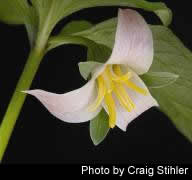
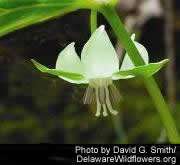 Distribution: This species is found mostly in southern Canada and northeastern U.S. In West Virginia, a small population exists in Jefferson County. Although the species was collected near Wheeling in the late 1800s, a recent report from Brooke County appears to have been a misidentification.
Distribution: This species is found mostly in southern Canada and northeastern U.S. In West Virginia, a small population exists in Jefferson County. Although the species was collected near Wheeling in the late 1800s, a recent report from Brooke County appears to have been a misidentification. 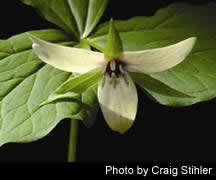 Distribution: This trillium is found across most of the northeast, extending south in the Appalachian Mountains. It is found throughout the state.
Distribution: This trillium is found across most of the northeast, extending south in the Appalachian Mountains. It is found throughout the state. 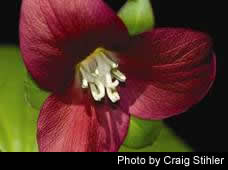 Distribution: The range of this species is centered west of the Ohio River. In West Virginia it is known only from Wood County, although there is an old record from Raleigh County.
Distribution: The range of this species is centered west of the Ohio River. In West Virginia it is known only from Wood County, although there is an old record from Raleigh County. 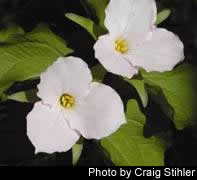 Distribution: This species is found in the northeast and northcentral U.S. and southward in the Appalachian Mountains. Common throughout the state.
Distribution: This species is found in the northeast and northcentral U.S. and southward in the Appalachian Mountains. Common throughout the state. 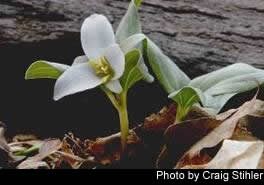 Distribution: This species occurs in scattered populations, mostly at the southern edge of the Pleistocene glaciation. In West Virginia there are scattered populations associated with limestone outcroppings.
Distribution: This species occurs in scattered populations, mostly at the southern edge of the Pleistocene glaciation. In West Virginia there are scattered populations associated with limestone outcroppings. 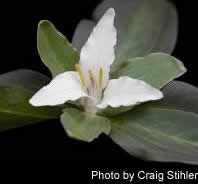 Distribution: This species occurs in widely disjunct populations scattered across the Southeast. In West Virginia it is found at one site on Shenandoah Mountain .
Distribution: This species occurs in widely disjunct populations scattered across the Southeast. In West Virginia it is found at one site on Shenandoah Mountain . 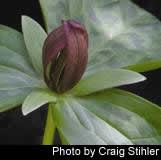 Distribution: The center of the species' range is Ohio, Indiana and Kentucky. Populations in West Virginia are widely scattered.
Distribution: The center of the species' range is Ohio, Indiana and Kentucky. Populations in West Virginia are widely scattered. 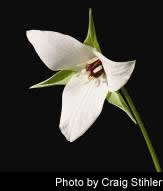 Distribution: Range mostly in southern Appalachian Mountains south of West Virginia. In West Virginia , found in southern counties with one known population in Doddridge County.
Distribution: Range mostly in southern Appalachian Mountains south of West Virginia. In West Virginia , found in southern counties with one known population in Doddridge County. 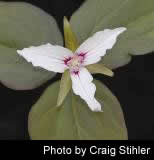 Distribution: This trillium is found in the northeastern U.S. and adjacent Canada, extending south in the Appalachian Mountains. Found mostly in the mountain counties of West Virginia.
Distribution: This trillium is found in the northeastern U.S. and adjacent Canada, extending south in the Appalachian Mountains. Found mostly in the mountain counties of West Virginia.